Implementation of Operation Management Principles in Cross Rail Project
VerifiedAdded on 2022/12/29
|18
|5205
|44
AI Summary
This report reviews and critiques the implementation of operation management principles within the Cross Rail project. It discusses the use of Six Sigma methodology and lean principles for continuous improvement. It also analyzes the stages of the project life cycle and the effectiveness of project methodologies. The report is based on the Cross Rail project, a railway construction project in London.
Contribute Materials
Your contribution can guide someone’s learning journey. Share your
documents today.
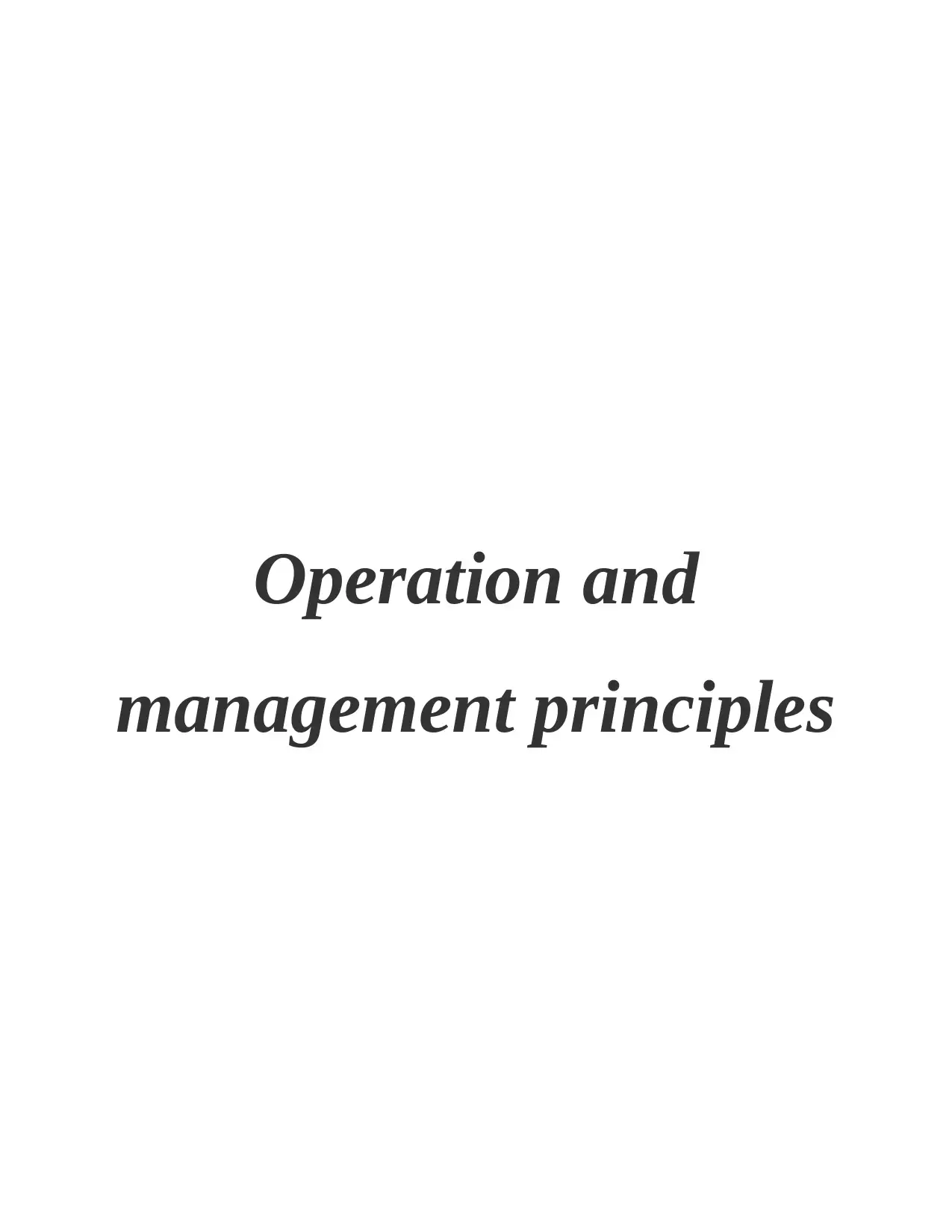
Operation and
management principles
management principles
Secure Best Marks with AI Grader
Need help grading? Try our AI Grader for instant feedback on your assignments.
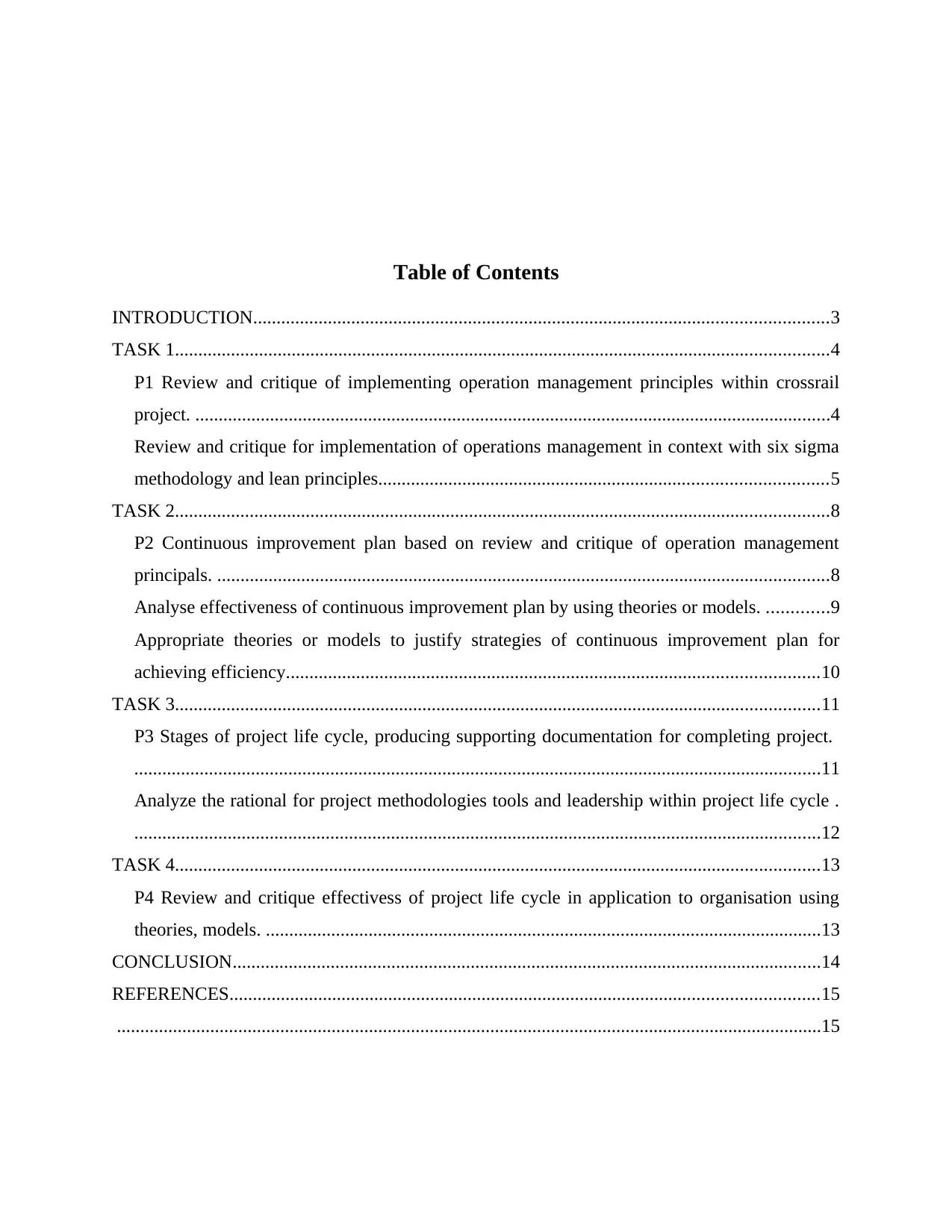
Table of Contents
INTRODUCTION...........................................................................................................................3
TASK 1............................................................................................................................................4
P1 Review and critique of implementing operation management principles within crossrail
project. ........................................................................................................................................4
Review and critique for implementation of operations management in context with six sigma
methodology and lean principles................................................................................................5
TASK 2............................................................................................................................................8
P2 Continuous improvement plan based on review and critique of operation management
principals. ...................................................................................................................................8
Analyse effectiveness of continuous improvement plan by using theories or models. .............9
Appropriate theories or models to justify strategies of continuous improvement plan for
achieving efficiency..................................................................................................................10
TASK 3..........................................................................................................................................11
P3 Stages of project life cycle, producing supporting documentation for completing project.
...................................................................................................................................................11
Analyze the rational for project methodologies tools and leadership within project life cycle .
...................................................................................................................................................12
TASK 4..........................................................................................................................................13
P4 Review and critique effectivess of project life cycle in application to organisation using
theories, models. .......................................................................................................................13
CONCLUSION..............................................................................................................................14
REFERENCES..............................................................................................................................15
.......................................................................................................................................................15
INTRODUCTION...........................................................................................................................3
TASK 1............................................................................................................................................4
P1 Review and critique of implementing operation management principles within crossrail
project. ........................................................................................................................................4
Review and critique for implementation of operations management in context with six sigma
methodology and lean principles................................................................................................5
TASK 2............................................................................................................................................8
P2 Continuous improvement plan based on review and critique of operation management
principals. ...................................................................................................................................8
Analyse effectiveness of continuous improvement plan by using theories or models. .............9
Appropriate theories or models to justify strategies of continuous improvement plan for
achieving efficiency..................................................................................................................10
TASK 3..........................................................................................................................................11
P3 Stages of project life cycle, producing supporting documentation for completing project.
...................................................................................................................................................11
Analyze the rational for project methodologies tools and leadership within project life cycle .
...................................................................................................................................................12
TASK 4..........................................................................................................................................13
P4 Review and critique effectivess of project life cycle in application to organisation using
theories, models. .......................................................................................................................13
CONCLUSION..............................................................................................................................14
REFERENCES..............................................................................................................................15
.......................................................................................................................................................15
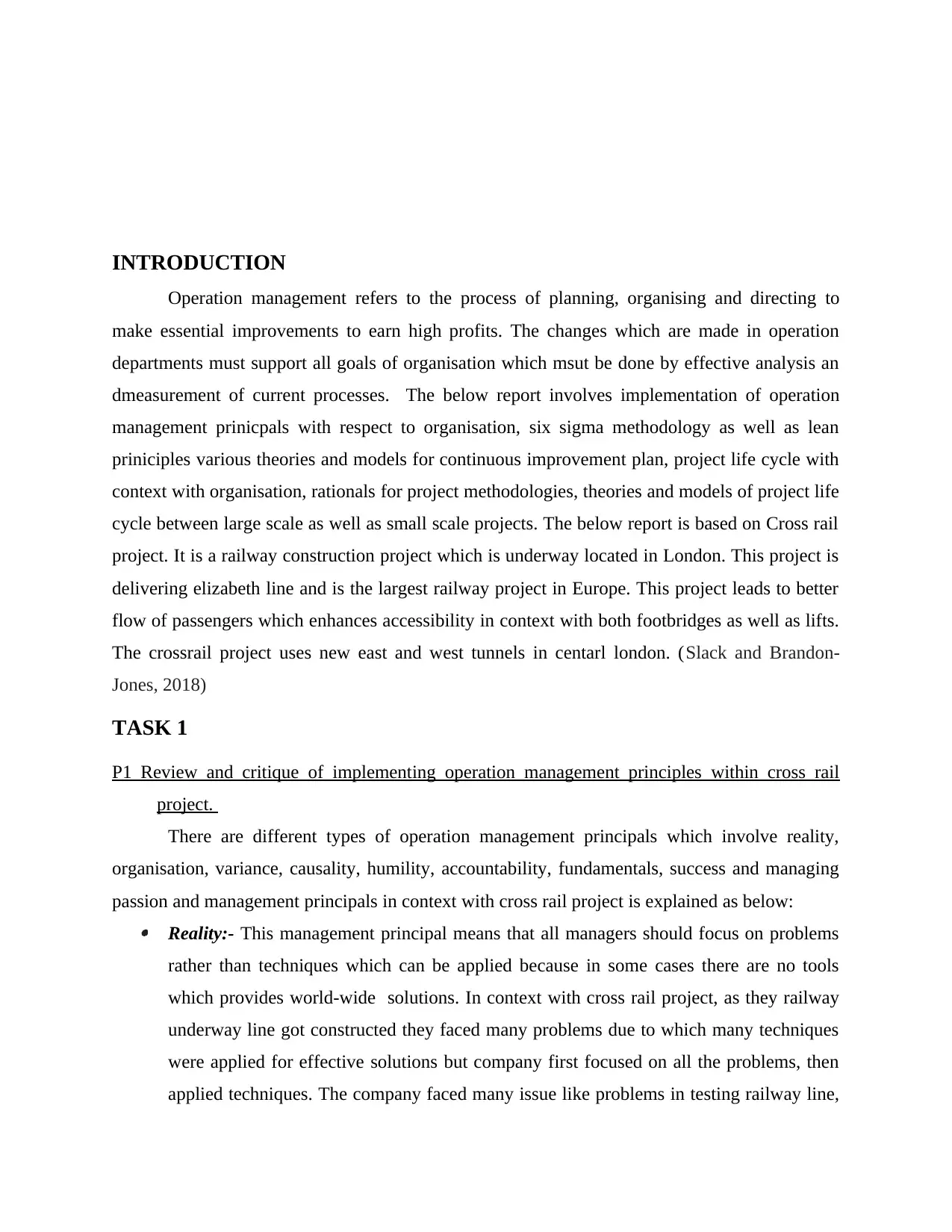
INTRODUCTION
Operation management refers to the process of planning, organising and directing to
make essential improvements to earn high profits. The changes which are made in operation
departments must support all goals of organisation which msut be done by effective analysis an
dmeasurement of current processes. The below report involves implementation of operation
management prinicpals with respect to organisation, six sigma methodology as well as lean
priniciples various theories and models for continuous improvement plan, project life cycle with
context with organisation, rationals for project methodologies, theories and models of project life
cycle between large scale as well as small scale projects. The below report is based on Cross rail
project. It is a railway construction project which is underway located in London. This project is
delivering elizabeth line and is the largest railway project in Europe. This project leads to better
flow of passengers which enhances accessibility in context with both footbridges as well as lifts.
The crossrail project uses new east and west tunnels in centarl london. (Slack and Brandon-
Jones, 2018)
TASK 1
P1 Review and critique of implementing operation management principles within cross rail
project.
There are different types of operation management principals which involve reality,
organisation, variance, causality, humility, accountability, fundamentals, success and managing
passion and management principals in context with cross rail project is explained as below: Reality:- This management principal means that all managers should focus on problems
rather than techniques which can be applied because in some cases there are no tools
which provides world-wide solutions. In context with cross rail project, as they railway
underway line got constructed they faced many problems due to which many techniques
were applied for effective solutions but company first focused on all the problems, then
applied techniques. The company faced many issue like problems in testing railway line,
Operation management refers to the process of planning, organising and directing to
make essential improvements to earn high profits. The changes which are made in operation
departments must support all goals of organisation which msut be done by effective analysis an
dmeasurement of current processes. The below report involves implementation of operation
management prinicpals with respect to organisation, six sigma methodology as well as lean
priniciples various theories and models for continuous improvement plan, project life cycle with
context with organisation, rationals for project methodologies, theories and models of project life
cycle between large scale as well as small scale projects. The below report is based on Cross rail
project. It is a railway construction project which is underway located in London. This project is
delivering elizabeth line and is the largest railway project in Europe. This project leads to better
flow of passengers which enhances accessibility in context with both footbridges as well as lifts.
The crossrail project uses new east and west tunnels in centarl london. (Slack and Brandon-
Jones, 2018)
TASK 1
P1 Review and critique of implementing operation management principles within cross rail
project.
There are different types of operation management principals which involve reality,
organisation, variance, causality, humility, accountability, fundamentals, success and managing
passion and management principals in context with cross rail project is explained as below: Reality:- This management principal means that all managers should focus on problems
rather than techniques which can be applied because in some cases there are no tools
which provides world-wide solutions. In context with cross rail project, as they railway
underway line got constructed they faced many problems due to which many techniques
were applied for effective solutions but company first focused on all the problems, then
applied techniques. The company faced many issue like problems in testing railway line,
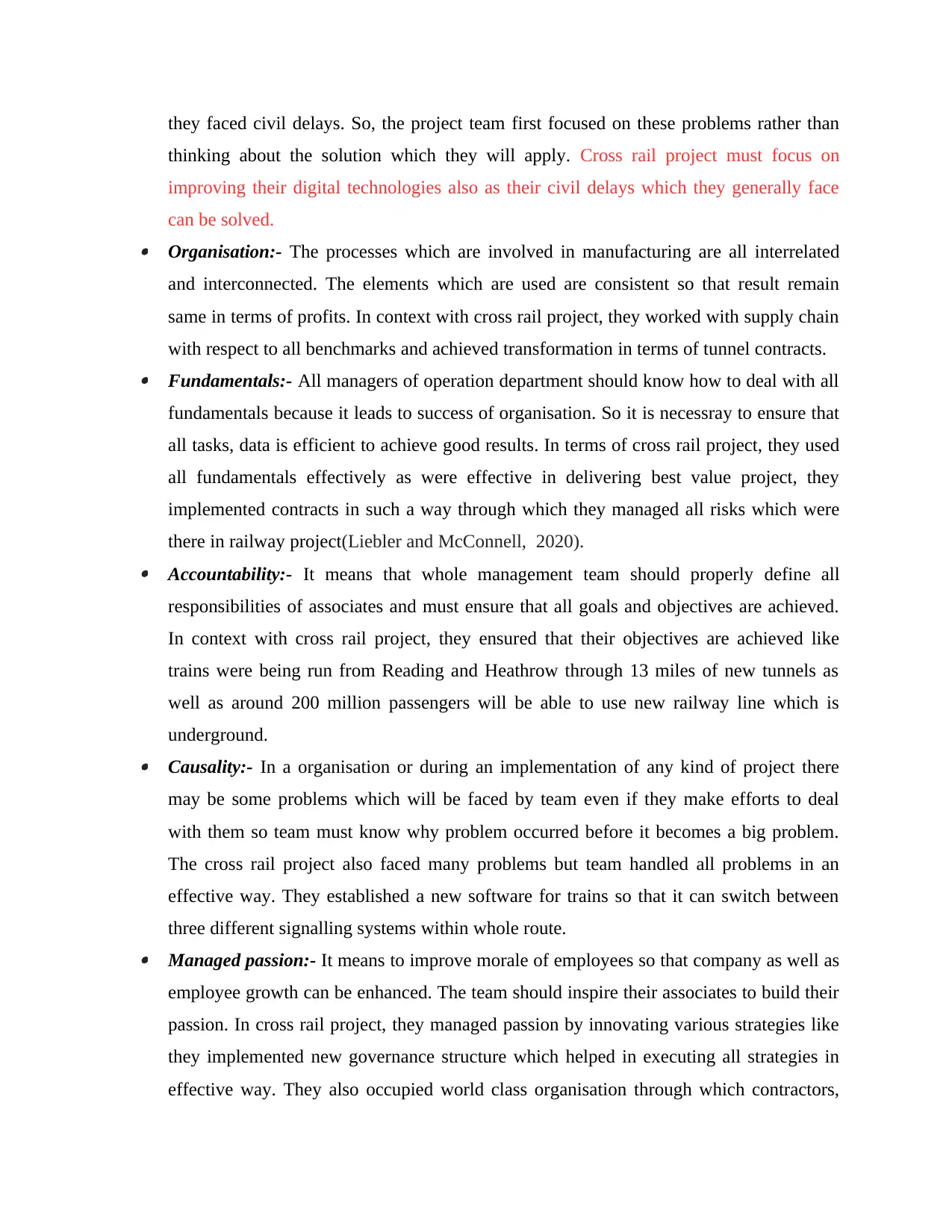
they faced civil delays. So, the project team first focused on these problems rather than
thinking about the solution which they will apply. Cross rail project must focus on
improving their digital technologies also as their civil delays which they generally face
can be solved. Organisation:- The processes which are involved in manufacturing are all interrelated
and interconnected. The elements which are used are consistent so that result remain
same in terms of profits. In context with cross rail project, they worked with supply chain
with respect to all benchmarks and achieved transformation in terms of tunnel contracts. Fundamentals:- All managers of operation department should know how to deal with all
fundamentals because it leads to success of organisation. So it is necessray to ensure that
all tasks, data is efficient to achieve good results. In terms of cross rail project, they used
all fundamentals effectively as were effective in delivering best value project, they
implemented contracts in such a way through which they managed all risks which were
there in railway project(Liebler and McConnell, 2020). Accountability:- It means that whole management team should properly define all
responsibilities of associates and must ensure that all goals and objectives are achieved.
In context with cross rail project, they ensured that their objectives are achieved like
trains were being run from Reading and Heathrow through 13 miles of new tunnels as
well as around 200 million passengers will be able to use new railway line which is
underground. Causality:- In a organisation or during an implementation of any kind of project there
may be some problems which will be faced by team even if they make efforts to deal
with them so team must know why problem occurred before it becomes a big problem.
The cross rail project also faced many problems but team handled all problems in an
effective way. They established a new software for trains so that it can switch between
three different signalling systems within whole route. Managed passion:- It means to improve morale of employees so that company as well as
employee growth can be enhanced. The team should inspire their associates to build their
passion. In cross rail project, they managed passion by innovating various strategies like
they implemented new governance structure which helped in executing all strategies in
effective way. They also occupied world class organisation through which contractors,
thinking about the solution which they will apply. Cross rail project must focus on
improving their digital technologies also as their civil delays which they generally face
can be solved. Organisation:- The processes which are involved in manufacturing are all interrelated
and interconnected. The elements which are used are consistent so that result remain
same in terms of profits. In context with cross rail project, they worked with supply chain
with respect to all benchmarks and achieved transformation in terms of tunnel contracts. Fundamentals:- All managers of operation department should know how to deal with all
fundamentals because it leads to success of organisation. So it is necessray to ensure that
all tasks, data is efficient to achieve good results. In terms of cross rail project, they used
all fundamentals effectively as were effective in delivering best value project, they
implemented contracts in such a way through which they managed all risks which were
there in railway project(Liebler and McConnell, 2020). Accountability:- It means that whole management team should properly define all
responsibilities of associates and must ensure that all goals and objectives are achieved.
In context with cross rail project, they ensured that their objectives are achieved like
trains were being run from Reading and Heathrow through 13 miles of new tunnels as
well as around 200 million passengers will be able to use new railway line which is
underground. Causality:- In a organisation or during an implementation of any kind of project there
may be some problems which will be faced by team even if they make efforts to deal
with them so team must know why problem occurred before it becomes a big problem.
The cross rail project also faced many problems but team handled all problems in an
effective way. They established a new software for trains so that it can switch between
three different signalling systems within whole route. Managed passion:- It means to improve morale of employees so that company as well as
employee growth can be enhanced. The team should inspire their associates to build their
passion. In cross rail project, they managed passion by innovating various strategies like
they implemented new governance structure which helped in executing all strategies in
effective way. They also occupied world class organisation through which contractors,
Secure Best Marks with AI Grader
Need help grading? Try our AI Grader for instant feedback on your assignments.
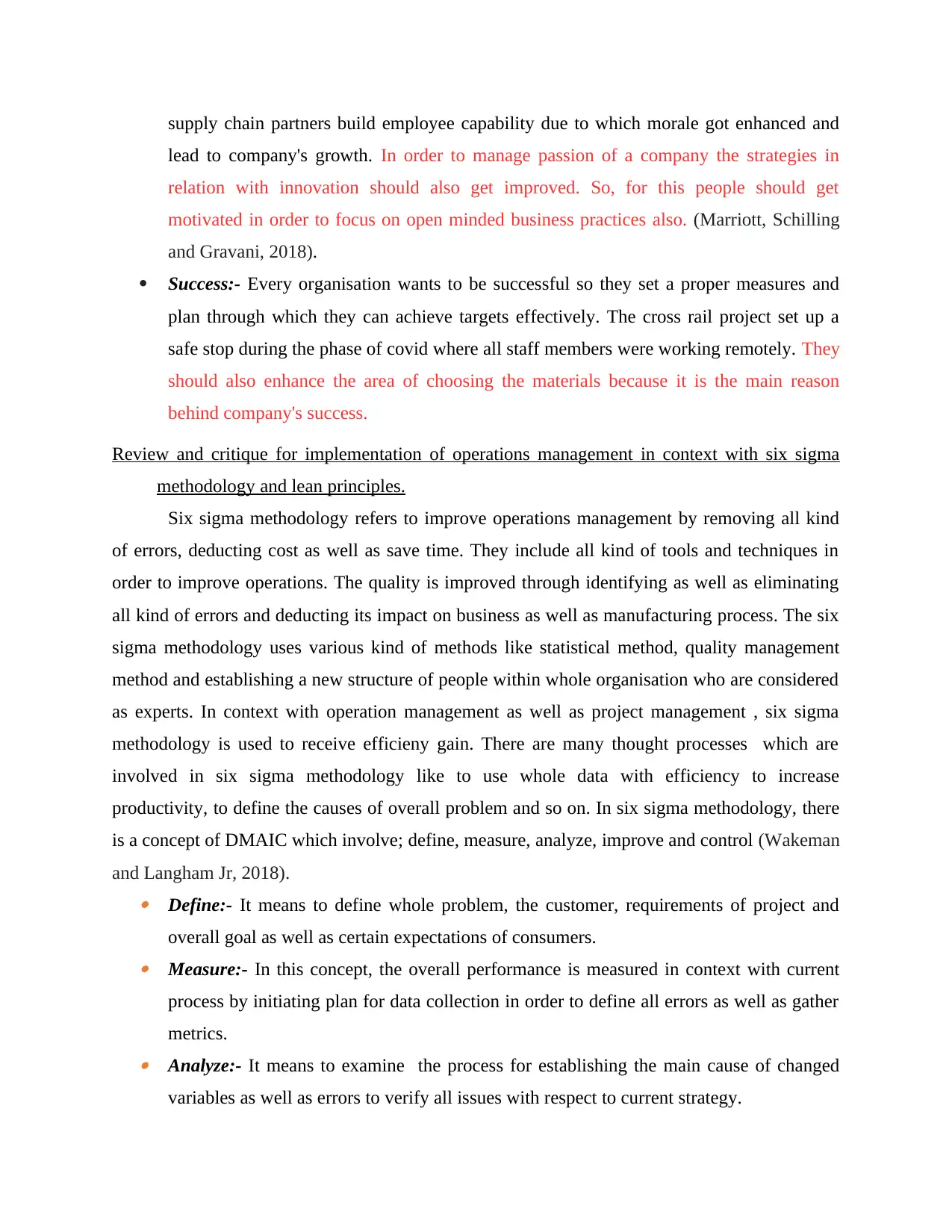
supply chain partners build employee capability due to which morale got enhanced and
lead to company's growth. In order to manage passion of a company the strategies in
relation with innovation should also get improved. So, for this people should get
motivated in order to focus on open minded business practices also. (Marriott, Schilling
and Gravani, 2018).
Success:- Every organisation wants to be successful so they set a proper measures and
plan through which they can achieve targets effectively. The cross rail project set up a
safe stop during the phase of covid where all staff members were working remotely. They
should also enhance the area of choosing the materials because it is the main reason
behind company's success.
Review and critique for implementation of operations management in context with six sigma
methodology and lean principles.
Six sigma methodology refers to improve operations management by removing all kind
of errors, deducting cost as well as save time. They include all kind of tools and techniques in
order to improve operations. The quality is improved through identifying as well as eliminating
all kind of errors and deducting its impact on business as well as manufacturing process. The six
sigma methodology uses various kind of methods like statistical method, quality management
method and establishing a new structure of people within whole organisation who are considered
as experts. In context with operation management as well as project management , six sigma
methodology is used to receive efficieny gain. There are many thought processes which are
involved in six sigma methodology like to use whole data with efficiency to increase
productivity, to define the causes of overall problem and so on. In six sigma methodology, there
is a concept of DMAIC which involve; define, measure, analyze, improve and control (Wakeman
and Langham Jr, 2018). Define:- It means to define whole problem, the customer, requirements of project and
overall goal as well as certain expectations of consumers. Measure:- In this concept, the overall performance is measured in context with current
process by initiating plan for data collection in order to define all errors as well as gather
metrics. Analyze:- It means to examine the process for establishing the main cause of changed
variables as well as errors to verify all issues with respect to current strategy.
lead to company's growth. In order to manage passion of a company the strategies in
relation with innovation should also get improved. So, for this people should get
motivated in order to focus on open minded business practices also. (Marriott, Schilling
and Gravani, 2018).
Success:- Every organisation wants to be successful so they set a proper measures and
plan through which they can achieve targets effectively. The cross rail project set up a
safe stop during the phase of covid where all staff members were working remotely. They
should also enhance the area of choosing the materials because it is the main reason
behind company's success.
Review and critique for implementation of operations management in context with six sigma
methodology and lean principles.
Six sigma methodology refers to improve operations management by removing all kind
of errors, deducting cost as well as save time. They include all kind of tools and techniques in
order to improve operations. The quality is improved through identifying as well as eliminating
all kind of errors and deducting its impact on business as well as manufacturing process. The six
sigma methodology uses various kind of methods like statistical method, quality management
method and establishing a new structure of people within whole organisation who are considered
as experts. In context with operation management as well as project management , six sigma
methodology is used to receive efficieny gain. There are many thought processes which are
involved in six sigma methodology like to use whole data with efficiency to increase
productivity, to define the causes of overall problem and so on. In six sigma methodology, there
is a concept of DMAIC which involve; define, measure, analyze, improve and control (Wakeman
and Langham Jr, 2018). Define:- It means to define whole problem, the customer, requirements of project and
overall goal as well as certain expectations of consumers. Measure:- In this concept, the overall performance is measured in context with current
process by initiating plan for data collection in order to define all errors as well as gather
metrics. Analyze:- It means to examine the process for establishing the main cause of changed
variables as well as errors to verify all issues with respect to current strategy.
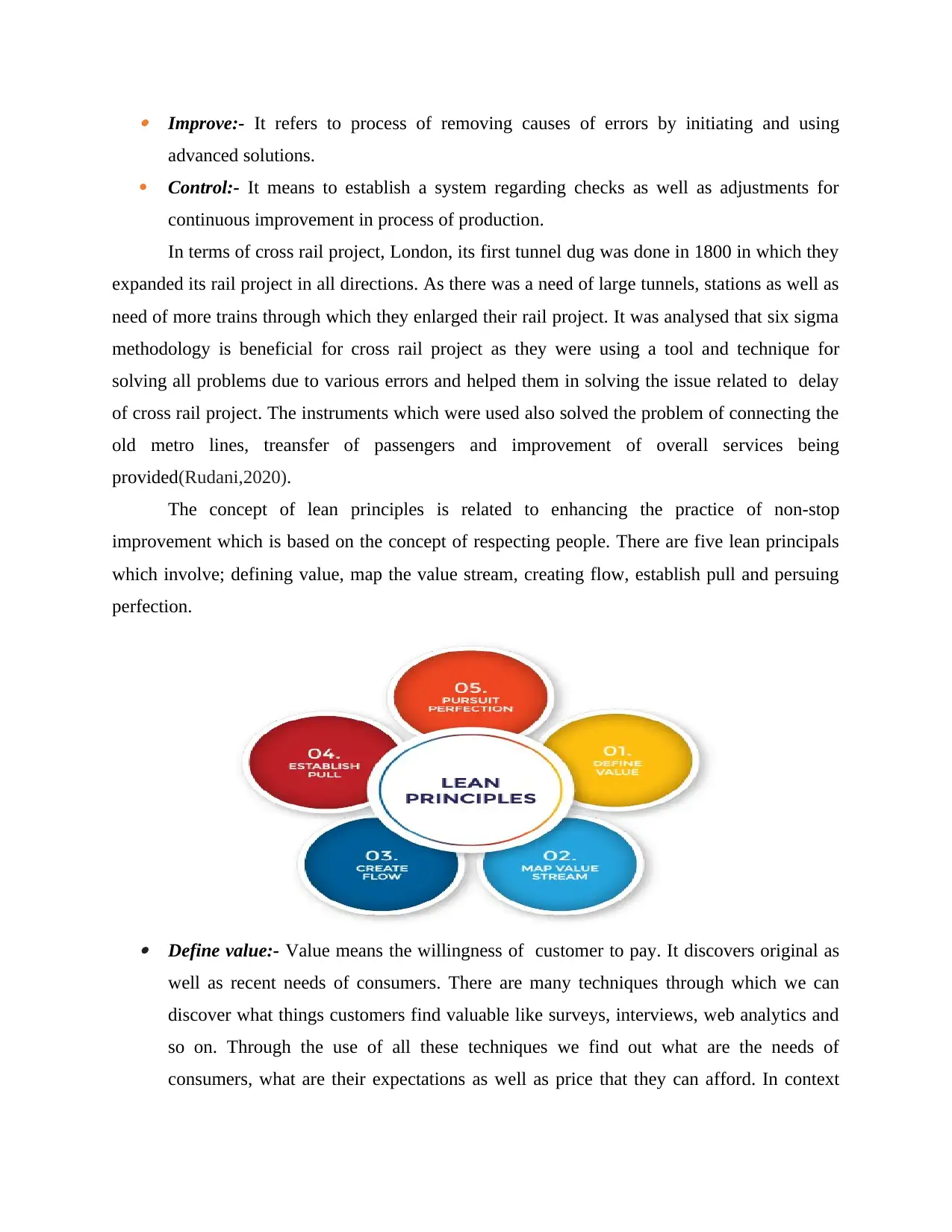
Improve:- It refers to process of removing causes of errors by initiating and using
advanced solutions.
Control:- It means to establish a system regarding checks as well as adjustments for
continuous improvement in process of production.
In terms of cross rail project, London, its first tunnel dug was done in 1800 in which they
expanded its rail project in all directions. As there was a need of large tunnels, stations as well as
need of more trains through which they enlarged their rail project. It was analysed that six sigma
methodology is beneficial for cross rail project as they were using a tool and technique for
solving all problems due to various errors and helped them in solving the issue related to delay
of cross rail project. The instruments which were used also solved the problem of connecting the
old metro lines, treansfer of passengers and improvement of overall services being
provided(Rudani,2020).
The concept of lean principles is related to enhancing the practice of non-stop
improvement which is based on the concept of respecting people. There are five lean principals
which involve; defining value, map the value stream, creating flow, establish pull and persuing
perfection.
Define value:- Value means the willingness of customer to pay. It discovers original as
well as recent needs of consumers. There are many techniques through which we can
discover what things customers find valuable like surveys, interviews, web analytics and
so on. Through the use of all these techniques we find out what are the needs of
consumers, what are their expectations as well as price that they can afford. In context
advanced solutions.
Control:- It means to establish a system regarding checks as well as adjustments for
continuous improvement in process of production.
In terms of cross rail project, London, its first tunnel dug was done in 1800 in which they
expanded its rail project in all directions. As there was a need of large tunnels, stations as well as
need of more trains through which they enlarged their rail project. It was analysed that six sigma
methodology is beneficial for cross rail project as they were using a tool and technique for
solving all problems due to various errors and helped them in solving the issue related to delay
of cross rail project. The instruments which were used also solved the problem of connecting the
old metro lines, treansfer of passengers and improvement of overall services being
provided(Rudani,2020).
The concept of lean principles is related to enhancing the practice of non-stop
improvement which is based on the concept of respecting people. There are five lean principals
which involve; defining value, map the value stream, creating flow, establish pull and persuing
perfection.
Define value:- Value means the willingness of customer to pay. It discovers original as
well as recent needs of consumers. There are many techniques through which we can
discover what things customers find valuable like surveys, interviews, web analytics and
so on. Through the use of all these techniques we find out what are the needs of
consumers, what are their expectations as well as price that they can afford. In context
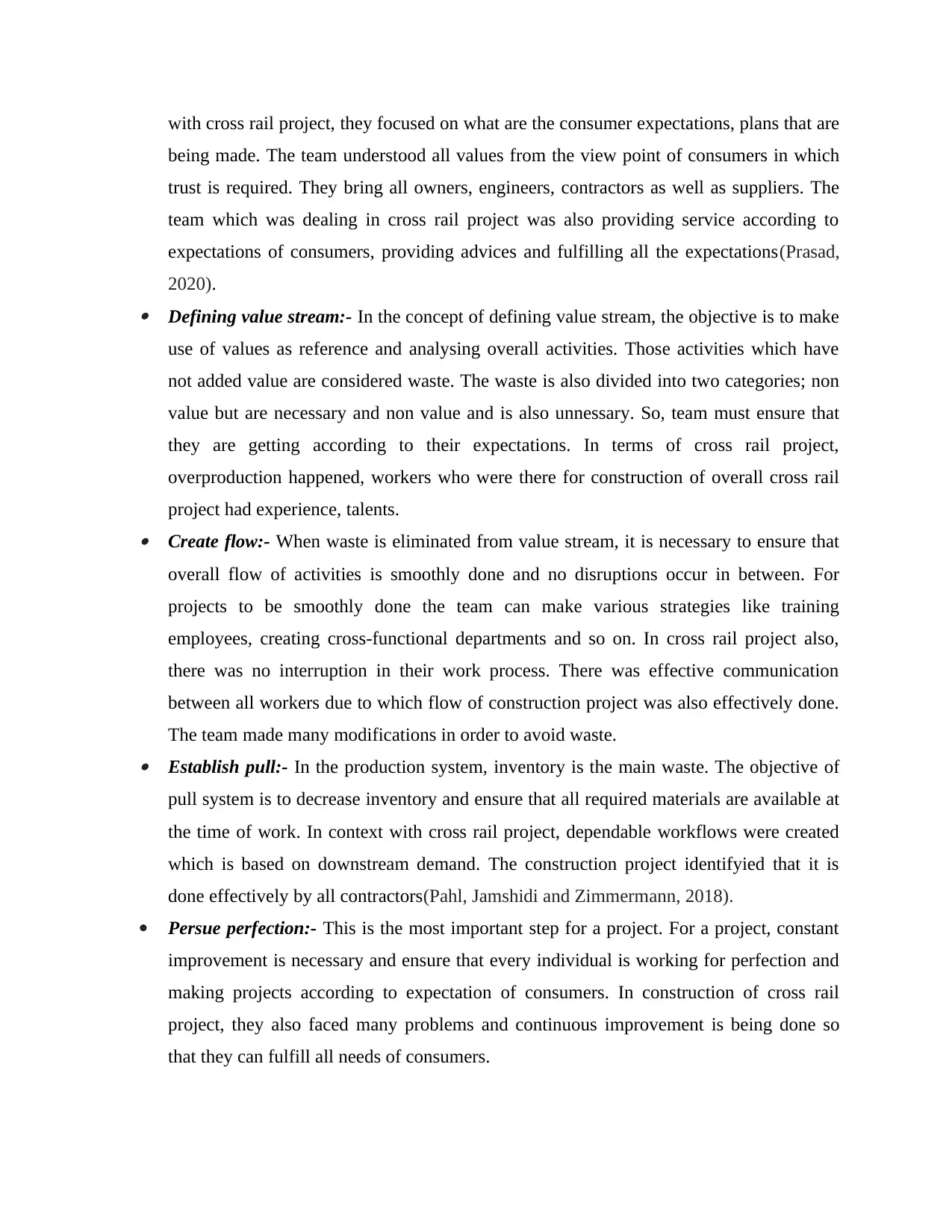
with cross rail project, they focused on what are the consumer expectations, plans that are
being made. The team understood all values from the view point of consumers in which
trust is required. They bring all owners, engineers, contractors as well as suppliers. The
team which was dealing in cross rail project was also providing service according to
expectations of consumers, providing advices and fulfilling all the expectations(Prasad,
2020). Defining value stream:- In the concept of defining value stream, the objective is to make
use of values as reference and analysing overall activities. Those activities which have
not added value are considered waste. The waste is also divided into two categories; non
value but are necessary and non value and is also unnessary. So, team must ensure that
they are getting according to their expectations. In terms of cross rail project,
overproduction happened, workers who were there for construction of overall cross rail
project had experience, talents. Create flow:- When waste is eliminated from value stream, it is necessary to ensure that
overall flow of activities is smoothly done and no disruptions occur in between. For
projects to be smoothly done the team can make various strategies like training
employees, creating cross-functional departments and so on. In cross rail project also,
there was no interruption in their work process. There was effective communication
between all workers due to which flow of construction project was also effectively done.
The team made many modifications in order to avoid waste. Establish pull:- In the production system, inventory is the main waste. The objective of
pull system is to decrease inventory and ensure that all required materials are available at
the time of work. In context with cross rail project, dependable workflows were created
which is based on downstream demand. The construction project identifyied that it is
done effectively by all contractors(Pahl, Jamshidi and Zimmermann, 2018).
Persue perfection:- This is the most important step for a project. For a project, constant
improvement is necessary and ensure that every individual is working for perfection and
making projects according to expectation of consumers. In construction of cross rail
project, they also faced many problems and continuous improvement is being done so
that they can fulfill all needs of consumers.
being made. The team understood all values from the view point of consumers in which
trust is required. They bring all owners, engineers, contractors as well as suppliers. The
team which was dealing in cross rail project was also providing service according to
expectations of consumers, providing advices and fulfilling all the expectations(Prasad,
2020). Defining value stream:- In the concept of defining value stream, the objective is to make
use of values as reference and analysing overall activities. Those activities which have
not added value are considered waste. The waste is also divided into two categories; non
value but are necessary and non value and is also unnessary. So, team must ensure that
they are getting according to their expectations. In terms of cross rail project,
overproduction happened, workers who were there for construction of overall cross rail
project had experience, talents. Create flow:- When waste is eliminated from value stream, it is necessary to ensure that
overall flow of activities is smoothly done and no disruptions occur in between. For
projects to be smoothly done the team can make various strategies like training
employees, creating cross-functional departments and so on. In cross rail project also,
there was no interruption in their work process. There was effective communication
between all workers due to which flow of construction project was also effectively done.
The team made many modifications in order to avoid waste. Establish pull:- In the production system, inventory is the main waste. The objective of
pull system is to decrease inventory and ensure that all required materials are available at
the time of work. In context with cross rail project, dependable workflows were created
which is based on downstream demand. The construction project identifyied that it is
done effectively by all contractors(Pahl, Jamshidi and Zimmermann, 2018).
Persue perfection:- This is the most important step for a project. For a project, constant
improvement is necessary and ensure that every individual is working for perfection and
making projects according to expectation of consumers. In construction of cross rail
project, they also faced many problems and continuous improvement is being done so
that they can fulfill all needs of consumers.
Paraphrase This Document
Need a fresh take? Get an instant paraphrase of this document with our AI Paraphraser
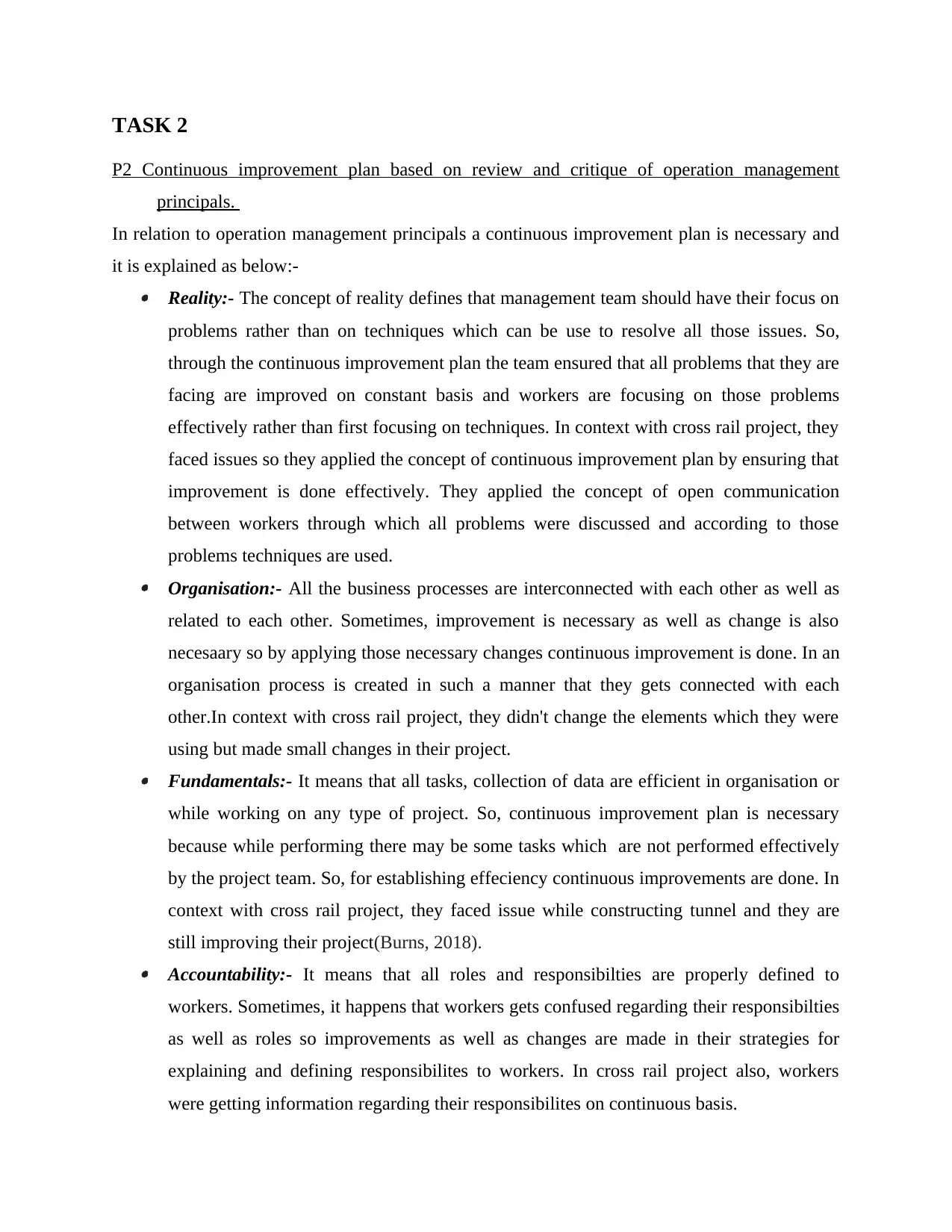
TASK 2
P2 Continuous improvement plan based on review and critique of operation management
principals.
In relation to operation management principals a continuous improvement plan is necessary and
it is explained as below:- Reality:- The concept of reality defines that management team should have their focus on
problems rather than on techniques which can be use to resolve all those issues. So,
through the continuous improvement plan the team ensured that all problems that they are
facing are improved on constant basis and workers are focusing on those problems
effectively rather than first focusing on techniques. In context with cross rail project, they
faced issues so they applied the concept of continuous improvement plan by ensuring that
improvement is done effectively. They applied the concept of open communication
between workers through which all problems were discussed and according to those
problems techniques are used. Organisation:- All the business processes are interconnected with each other as well as
related to each other. Sometimes, improvement is necessary as well as change is also
necesaary so by applying those necessary changes continuous improvement is done. In an
organisation process is created in such a manner that they gets connected with each
other.In context with cross rail project, they didn't change the elements which they were
using but made small changes in their project. Fundamentals:- It means that all tasks, collection of data are efficient in organisation or
while working on any type of project. So, continuous improvement plan is necessary
because while performing there may be some tasks which are not performed effectively
by the project team. So, for establishing effeciency continuous improvements are done. In
context with cross rail project, they faced issue while constructing tunnel and they are
still improving their project(Burns, 2018). Accountability:- It means that all roles and responsibilties are properly defined to
workers. Sometimes, it happens that workers gets confused regarding their responsibilties
as well as roles so improvements as well as changes are made in their strategies for
explaining and defining responsibilites to workers. In cross rail project also, workers
were getting information regarding their responsibilites on continuous basis.
P2 Continuous improvement plan based on review and critique of operation management
principals.
In relation to operation management principals a continuous improvement plan is necessary and
it is explained as below:- Reality:- The concept of reality defines that management team should have their focus on
problems rather than on techniques which can be use to resolve all those issues. So,
through the continuous improvement plan the team ensured that all problems that they are
facing are improved on constant basis and workers are focusing on those problems
effectively rather than first focusing on techniques. In context with cross rail project, they
faced issues so they applied the concept of continuous improvement plan by ensuring that
improvement is done effectively. They applied the concept of open communication
between workers through which all problems were discussed and according to those
problems techniques are used. Organisation:- All the business processes are interconnected with each other as well as
related to each other. Sometimes, improvement is necessary as well as change is also
necesaary so by applying those necessary changes continuous improvement is done. In an
organisation process is created in such a manner that they gets connected with each
other.In context with cross rail project, they didn't change the elements which they were
using but made small changes in their project. Fundamentals:- It means that all tasks, collection of data are efficient in organisation or
while working on any type of project. So, continuous improvement plan is necessary
because while performing there may be some tasks which are not performed effectively
by the project team. So, for establishing effeciency continuous improvements are done. In
context with cross rail project, they faced issue while constructing tunnel and they are
still improving their project(Burns, 2018). Accountability:- It means that all roles and responsibilties are properly defined to
workers. Sometimes, it happens that workers gets confused regarding their responsibilties
as well as roles so improvements as well as changes are made in their strategies for
explaining and defining responsibilites to workers. In cross rail project also, workers
were getting information regarding their responsibilites on continuous basis.
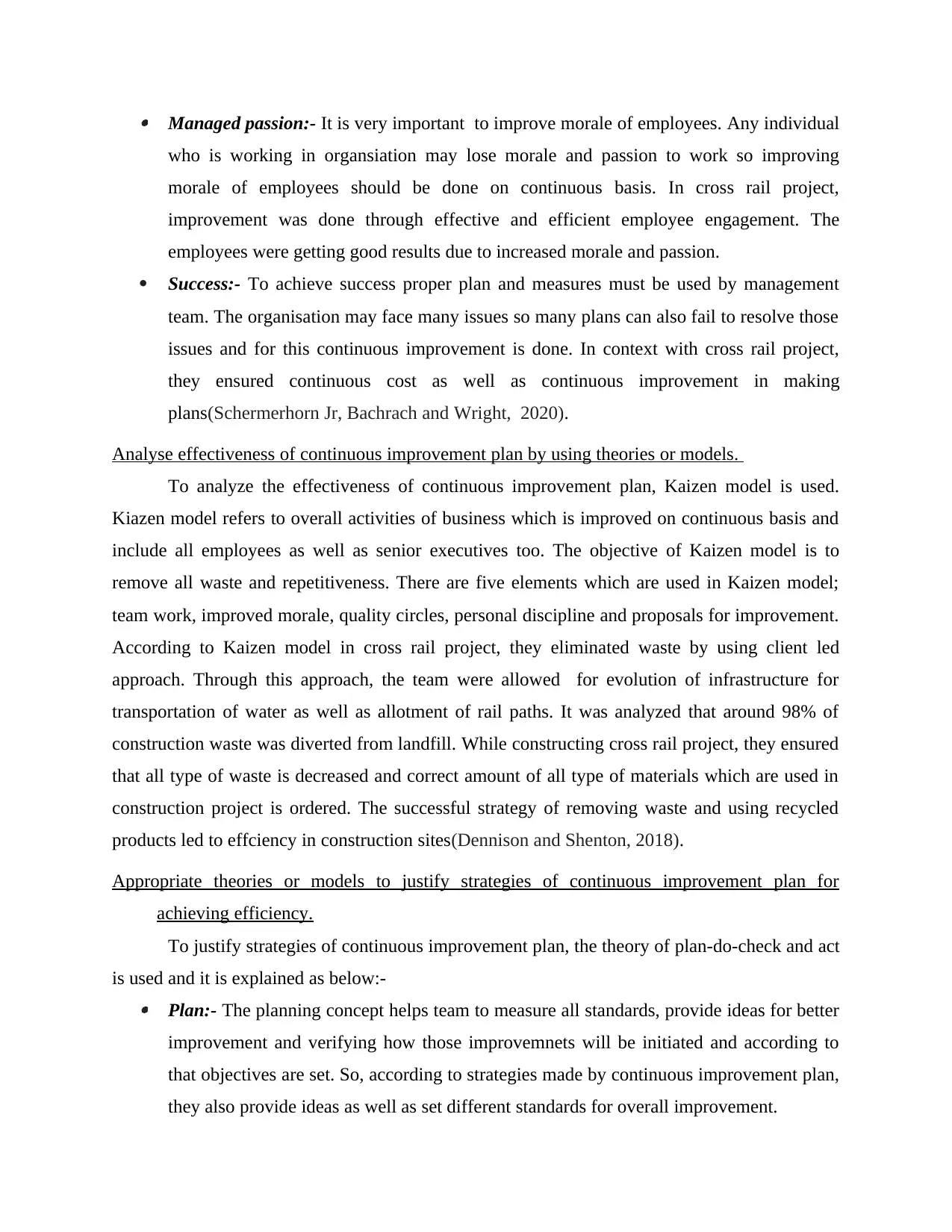
Managed passion:- It is very important to improve morale of employees. Any individual
who is working in organsiation may lose morale and passion to work so improving
morale of employees should be done on continuous basis. In cross rail project,
improvement was done through effective and efficient employee engagement. The
employees were getting good results due to increased morale and passion.
Success:- To achieve success proper plan and measures must be used by management
team. The organisation may face many issues so many plans can also fail to resolve those
issues and for this continuous improvement is done. In context with cross rail project,
they ensured continuous cost as well as continuous improvement in making
plans(Schermerhorn Jr, Bachrach and Wright, 2020).
Analyse effectiveness of continuous improvement plan by using theories or models.
To analyze the effectiveness of continuous improvement plan, Kaizen model is used.
Kiazen model refers to overall activities of business which is improved on continuous basis and
include all employees as well as senior executives too. The objective of Kaizen model is to
remove all waste and repetitiveness. There are five elements which are used in Kaizen model;
team work, improved morale, quality circles, personal discipline and proposals for improvement.
According to Kaizen model in cross rail project, they eliminated waste by using client led
approach. Through this approach, the team were allowed for evolution of infrastructure for
transportation of water as well as allotment of rail paths. It was analyzed that around 98% of
construction waste was diverted from landfill. While constructing cross rail project, they ensured
that all type of waste is decreased and correct amount of all type of materials which are used in
construction project is ordered. The successful strategy of removing waste and using recycled
products led to effciency in construction sites(Dennison and Shenton, 2018).
Appropriate theories or models to justify strategies of continuous improvement plan for
achieving efficiency.
To justify strategies of continuous improvement plan, the theory of plan-do-check and act
is used and it is explained as below:- Plan:- The planning concept helps team to measure all standards, provide ideas for better
improvement and verifying how those improvemnets will be initiated and according to
that objectives are set. So, according to strategies made by continuous improvement plan,
they also provide ideas as well as set different standards for overall improvement.
who is working in organsiation may lose morale and passion to work so improving
morale of employees should be done on continuous basis. In cross rail project,
improvement was done through effective and efficient employee engagement. The
employees were getting good results due to increased morale and passion.
Success:- To achieve success proper plan and measures must be used by management
team. The organisation may face many issues so many plans can also fail to resolve those
issues and for this continuous improvement is done. In context with cross rail project,
they ensured continuous cost as well as continuous improvement in making
plans(Schermerhorn Jr, Bachrach and Wright, 2020).
Analyse effectiveness of continuous improvement plan by using theories or models.
To analyze the effectiveness of continuous improvement plan, Kaizen model is used.
Kiazen model refers to overall activities of business which is improved on continuous basis and
include all employees as well as senior executives too. The objective of Kaizen model is to
remove all waste and repetitiveness. There are five elements which are used in Kaizen model;
team work, improved morale, quality circles, personal discipline and proposals for improvement.
According to Kaizen model in cross rail project, they eliminated waste by using client led
approach. Through this approach, the team were allowed for evolution of infrastructure for
transportation of water as well as allotment of rail paths. It was analyzed that around 98% of
construction waste was diverted from landfill. While constructing cross rail project, they ensured
that all type of waste is decreased and correct amount of all type of materials which are used in
construction project is ordered. The successful strategy of removing waste and using recycled
products led to effciency in construction sites(Dennison and Shenton, 2018).
Appropriate theories or models to justify strategies of continuous improvement plan for
achieving efficiency.
To justify strategies of continuous improvement plan, the theory of plan-do-check and act
is used and it is explained as below:- Plan:- The planning concept helps team to measure all standards, provide ideas for better
improvement and verifying how those improvemnets will be initiated and according to
that objectives are set. So, according to strategies made by continuous improvement plan,
they also provide ideas as well as set different standards for overall improvement.
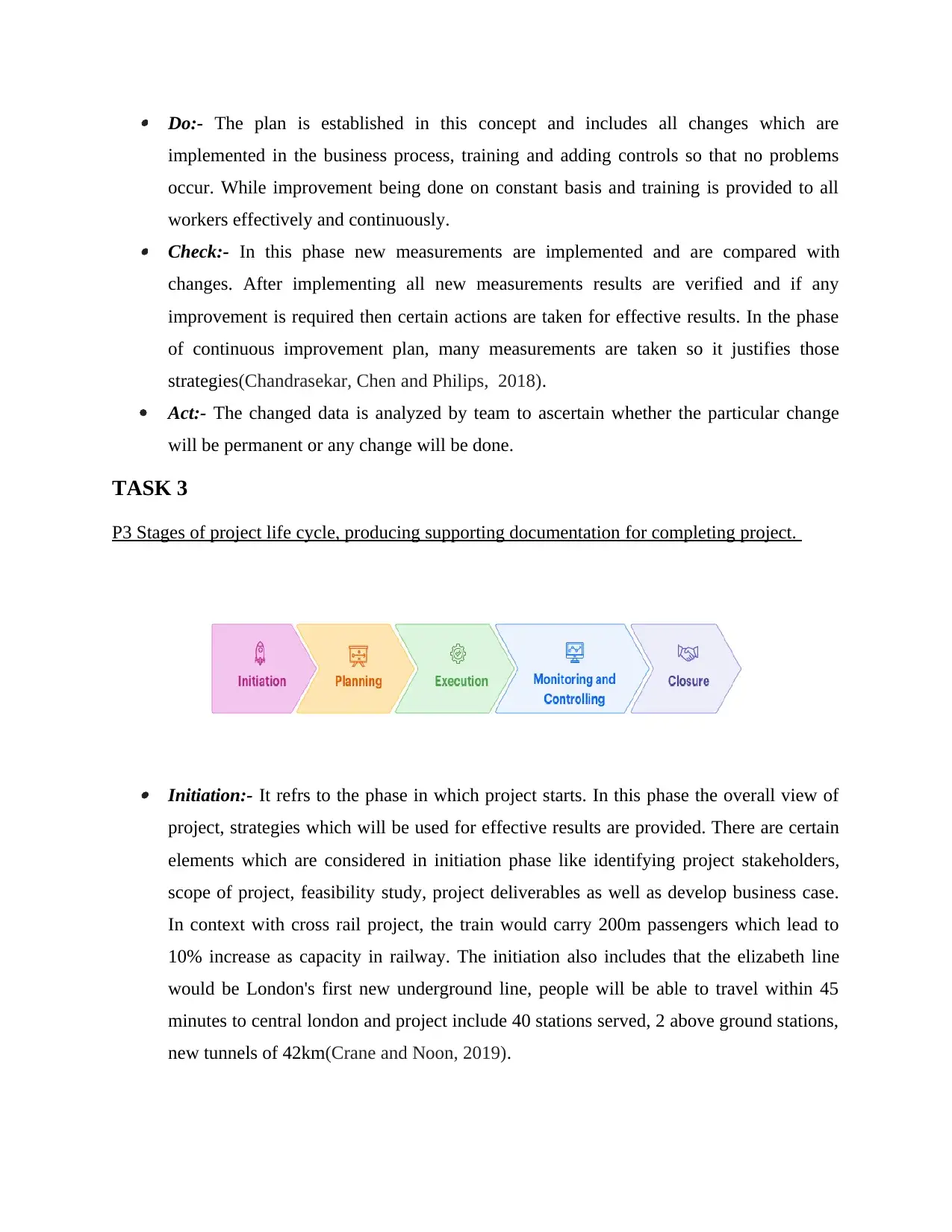
Do:- The plan is established in this concept and includes all changes which are
implemented in the business process, training and adding controls so that no problems
occur. While improvement being done on constant basis and training is provided to all
workers effectively and continuously. Check:- In this phase new measurements are implemented and are compared with
changes. After implementing all new measurements results are verified and if any
improvement is required then certain actions are taken for effective results. In the phase
of continuous improvement plan, many measurements are taken so it justifies those
strategies(Chandrasekar, Chen and Philips, 2018).
Act:- The changed data is analyzed by team to ascertain whether the particular change
will be permanent or any change will be done.
TASK 3
P3 Stages of project life cycle, producing supporting documentation for completing project.
Initiation:- It refrs to the phase in which project starts. In this phase the overall view of
project, strategies which will be used for effective results are provided. There are certain
elements which are considered in initiation phase like identifying project stakeholders,
scope of project, feasibility study, project deliverables as well as develop business case.
In context with cross rail project, the train would carry 200m passengers which lead to
10% increase as capacity in railway. The initiation also includes that the elizabeth line
would be London's first new underground line, people will be able to travel within 45
minutes to central london and project include 40 stations served, 2 above ground stations,
new tunnels of 42km(Crane and Noon, 2019).
implemented in the business process, training and adding controls so that no problems
occur. While improvement being done on constant basis and training is provided to all
workers effectively and continuously. Check:- In this phase new measurements are implemented and are compared with
changes. After implementing all new measurements results are verified and if any
improvement is required then certain actions are taken for effective results. In the phase
of continuous improvement plan, many measurements are taken so it justifies those
strategies(Chandrasekar, Chen and Philips, 2018).
Act:- The changed data is analyzed by team to ascertain whether the particular change
will be permanent or any change will be done.
TASK 3
P3 Stages of project life cycle, producing supporting documentation for completing project.
Initiation:- It refrs to the phase in which project starts. In this phase the overall view of
project, strategies which will be used for effective results are provided. There are certain
elements which are considered in initiation phase like identifying project stakeholders,
scope of project, feasibility study, project deliverables as well as develop business case.
In context with cross rail project, the train would carry 200m passengers which lead to
10% increase as capacity in railway. The initiation also includes that the elizabeth line
would be London's first new underground line, people will be able to travel within 45
minutes to central london and project include 40 stations served, 2 above ground stations,
new tunnels of 42km(Crane and Noon, 2019).
Secure Best Marks with AI Grader
Need help grading? Try our AI Grader for instant feedback on your assignments.
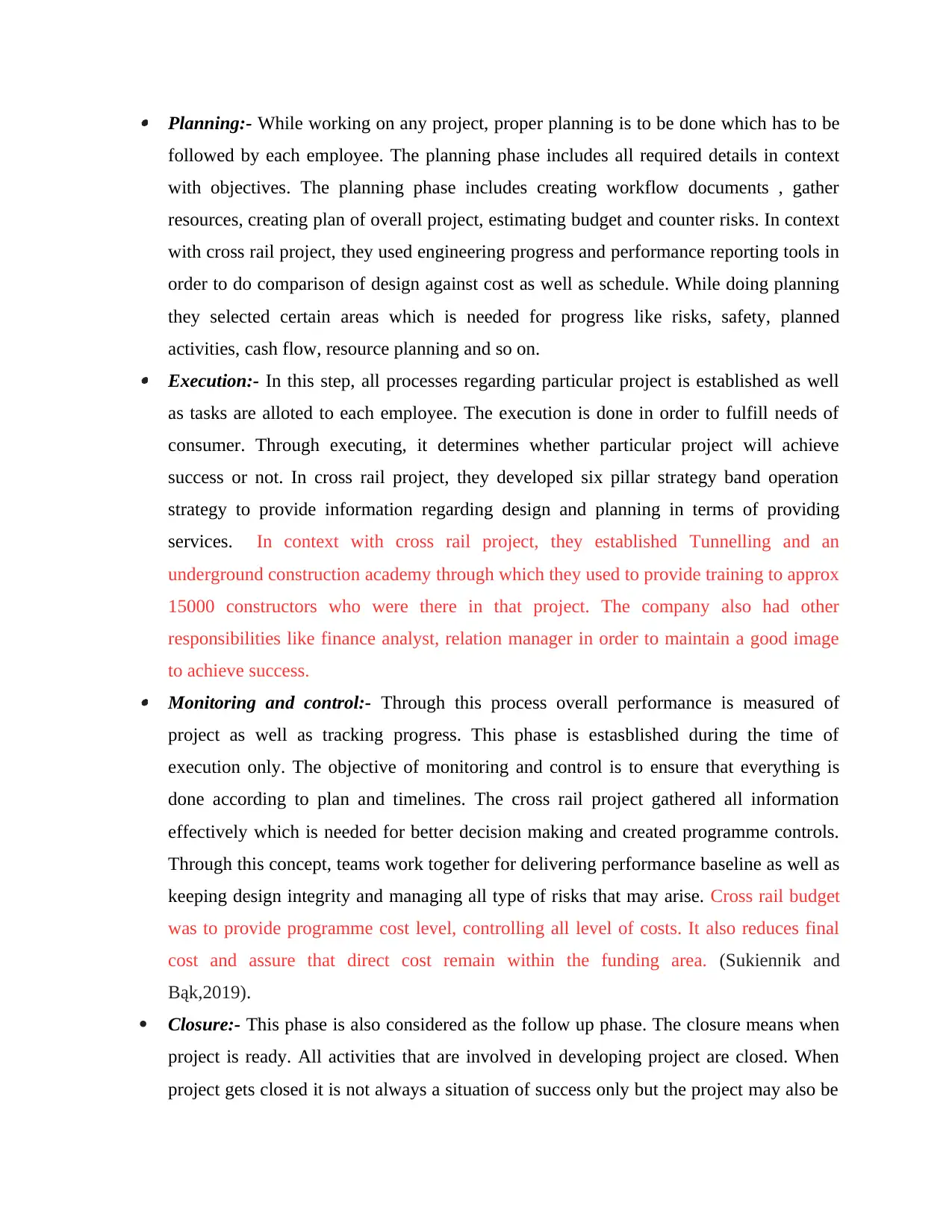
Planning:- While working on any project, proper planning is to be done which has to be
followed by each employee. The planning phase includes all required details in context
with objectives. The planning phase includes creating workflow documents , gather
resources, creating plan of overall project, estimating budget and counter risks. In context
with cross rail project, they used engineering progress and performance reporting tools in
order to do comparison of design against cost as well as schedule. While doing planning
they selected certain areas which is needed for progress like risks, safety, planned
activities, cash flow, resource planning and so on. Execution:- In this step, all processes regarding particular project is established as well
as tasks are alloted to each employee. The execution is done in order to fulfill needs of
consumer. Through executing, it determines whether particular project will achieve
success or not. In cross rail project, they developed six pillar strategy band operation
strategy to provide information regarding design and planning in terms of providing
services. In context with cross rail project, they established Tunnelling and an
underground construction academy through which they used to provide training to approx
15000 constructors who were there in that project. The company also had other
responsibilities like finance analyst, relation manager in order to maintain a good image
to achieve success. Monitoring and control:- Through this process overall performance is measured of
project as well as tracking progress. This phase is estasblished during the time of
execution only. The objective of monitoring and control is to ensure that everything is
done according to plan and timelines. The cross rail project gathered all information
effectively which is needed for better decision making and created programme controls.
Through this concept, teams work together for delivering performance baseline as well as
keeping design integrity and managing all type of risks that may arise. Cross rail budget
was to provide programme cost level, controlling all level of costs. It also reduces final
cost and assure that direct cost remain within the funding area. (Sukiennik and
Bąk,2019).
Closure:- This phase is also considered as the follow up phase. The closure means when
project is ready. All activities that are involved in developing project are closed. When
project gets closed it is not always a situation of success only but the project may also be
followed by each employee. The planning phase includes all required details in context
with objectives. The planning phase includes creating workflow documents , gather
resources, creating plan of overall project, estimating budget and counter risks. In context
with cross rail project, they used engineering progress and performance reporting tools in
order to do comparison of design against cost as well as schedule. While doing planning
they selected certain areas which is needed for progress like risks, safety, planned
activities, cash flow, resource planning and so on. Execution:- In this step, all processes regarding particular project is established as well
as tasks are alloted to each employee. The execution is done in order to fulfill needs of
consumer. Through executing, it determines whether particular project will achieve
success or not. In cross rail project, they developed six pillar strategy band operation
strategy to provide information regarding design and planning in terms of providing
services. In context with cross rail project, they established Tunnelling and an
underground construction academy through which they used to provide training to approx
15000 constructors who were there in that project. The company also had other
responsibilities like finance analyst, relation manager in order to maintain a good image
to achieve success. Monitoring and control:- Through this process overall performance is measured of
project as well as tracking progress. This phase is estasblished during the time of
execution only. The objective of monitoring and control is to ensure that everything is
done according to plan and timelines. The cross rail project gathered all information
effectively which is needed for better decision making and created programme controls.
Through this concept, teams work together for delivering performance baseline as well as
keeping design integrity and managing all type of risks that may arise. Cross rail budget
was to provide programme cost level, controlling all level of costs. It also reduces final
cost and assure that direct cost remain within the funding area. (Sukiennik and
Bąk,2019).
Closure:- This phase is also considered as the follow up phase. The closure means when
project is ready. All activities that are involved in developing project are closed. When
project gets closed it is not always a situation of success only but the project may also be
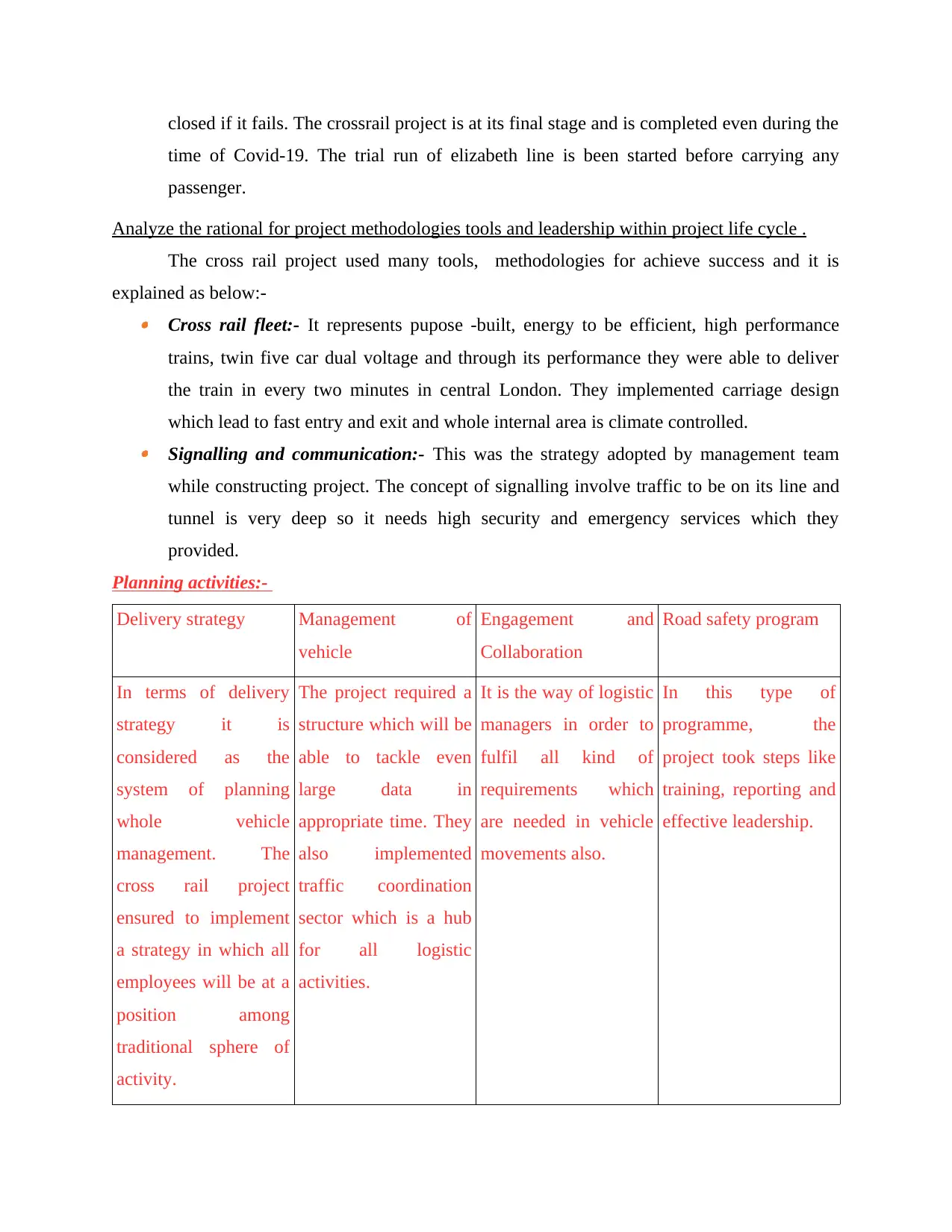
closed if it fails. The crossrail project is at its final stage and is completed even during the
time of Covid-19. The trial run of elizabeth line is been started before carrying any
passenger.
Analyze the rational for project methodologies tools and leadership within project life cycle .
The cross rail project used many tools, methodologies for achieve success and it is
explained as below:- Cross rail fleet:- It represents pupose -built, energy to be efficient, high performance
trains, twin five car dual voltage and through its performance they were able to deliver
the train in every two minutes in central London. They implemented carriage design
which lead to fast entry and exit and whole internal area is climate controlled. Signalling and communication:- This was the strategy adopted by management team
while constructing project. The concept of signalling involve traffic to be on its line and
tunnel is very deep so it needs high security and emergency services which they
provided.
Planning activities:-
Delivery strategy Management of
vehicle
Engagement and
Collaboration
Road safety program
In terms of delivery
strategy it is
considered as the
system of planning
whole vehicle
management. The
cross rail project
ensured to implement
a strategy in which all
employees will be at a
position among
traditional sphere of
activity.
The project required a
structure which will be
able to tackle even
large data in
appropriate time. They
also implemented
traffic coordination
sector which is a hub
for all logistic
activities.
It is the way of logistic
managers in order to
fulfil all kind of
requirements which
are needed in vehicle
movements also.
In this type of
programme, the
project took steps like
training, reporting and
effective leadership.
time of Covid-19. The trial run of elizabeth line is been started before carrying any
passenger.
Analyze the rational for project methodologies tools and leadership within project life cycle .
The cross rail project used many tools, methodologies for achieve success and it is
explained as below:- Cross rail fleet:- It represents pupose -built, energy to be efficient, high performance
trains, twin five car dual voltage and through its performance they were able to deliver
the train in every two minutes in central London. They implemented carriage design
which lead to fast entry and exit and whole internal area is climate controlled. Signalling and communication:- This was the strategy adopted by management team
while constructing project. The concept of signalling involve traffic to be on its line and
tunnel is very deep so it needs high security and emergency services which they
provided.
Planning activities:-
Delivery strategy Management of
vehicle
Engagement and
Collaboration
Road safety program
In terms of delivery
strategy it is
considered as the
system of planning
whole vehicle
management. The
cross rail project
ensured to implement
a strategy in which all
employees will be at a
position among
traditional sphere of
activity.
The project required a
structure which will be
able to tackle even
large data in
appropriate time. They
also implemented
traffic coordination
sector which is a hub
for all logistic
activities.
It is the way of logistic
managers in order to
fulfil all kind of
requirements which
are needed in vehicle
movements also.
In this type of
programme, the
project took steps like
training, reporting and
effective leadership.
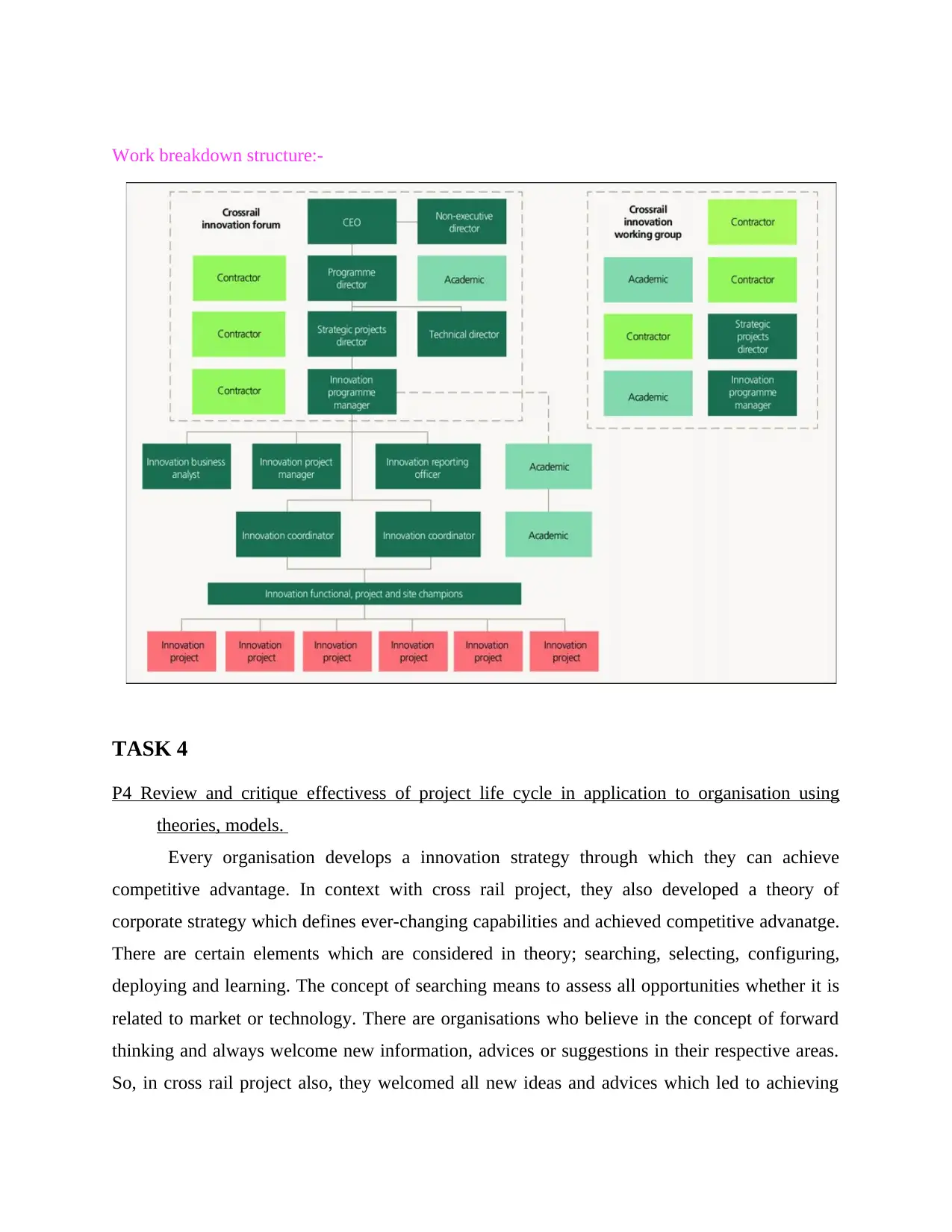
Work breakdown structure:-
TASK 4
P4 Review and critique effectivess of project life cycle in application to organisation using
theories, models.
Every organisation develops a innovation strategy through which they can achieve
competitive advantage. In context with cross rail project, they also developed a theory of
corporate strategy which defines ever-changing capabilities and achieved competitive advanatge.
There are certain elements which are considered in theory; searching, selecting, configuring,
deploying and learning. The concept of searching means to assess all opportunities whether it is
related to market or technology. There are organisations who believe in the concept of forward
thinking and always welcome new information, advices or suggestions in their respective areas.
So, in cross rail project also, they welcomed all new ideas and advices which led to achieving
TASK 4
P4 Review and critique effectivess of project life cycle in application to organisation using
theories, models.
Every organisation develops a innovation strategy through which they can achieve
competitive advantage. In context with cross rail project, they also developed a theory of
corporate strategy which defines ever-changing capabilities and achieved competitive advanatge.
There are certain elements which are considered in theory; searching, selecting, configuring,
deploying and learning. The concept of searching means to assess all opportunities whether it is
related to market or technology. There are organisations who believe in the concept of forward
thinking and always welcome new information, advices or suggestions in their respective areas.
So, in cross rail project also, they welcomed all new ideas and advices which led to achieving
Paraphrase This Document
Need a fresh take? Get an instant paraphrase of this document with our AI Paraphraser
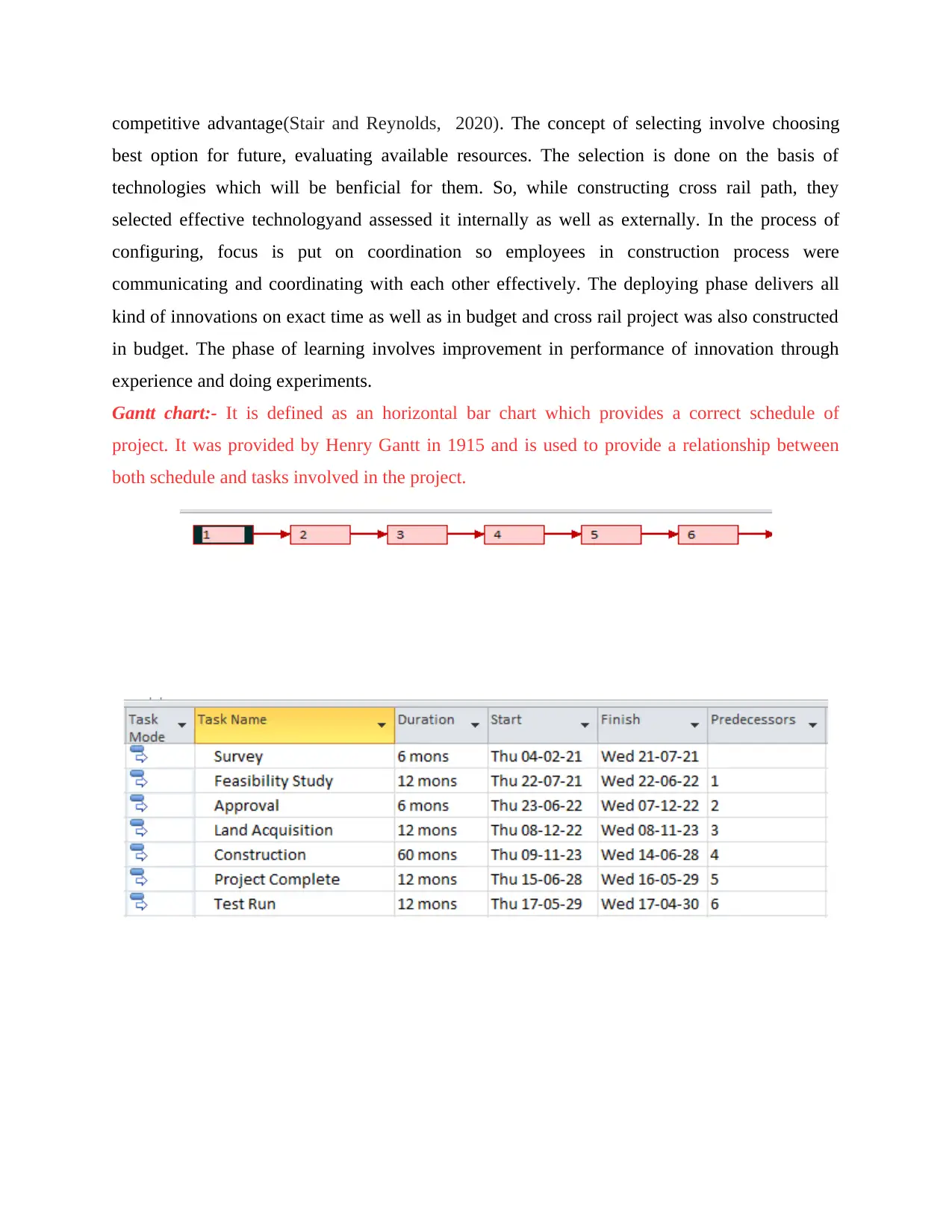
competitive advantage(Stair and Reynolds, 2020). The concept of selecting involve choosing
best option for future, evaluating available resources. The selection is done on the basis of
technologies which will be benficial for them. So, while constructing cross rail path, they
selected effective technologyand assessed it internally as well as externally. In the process of
configuring, focus is put on coordination so employees in construction process were
communicating and coordinating with each other effectively. The deploying phase delivers all
kind of innovations on exact time as well as in budget and cross rail project was also constructed
in budget. The phase of learning involves improvement in performance of innovation through
experience and doing experiments.
Gantt chart:- It is defined as an horizontal bar chart which provides a correct schedule of
project. It was provided by Henry Gantt in 1915 and is used to provide a relationship between
both schedule and tasks involved in the project.
best option for future, evaluating available resources. The selection is done on the basis of
technologies which will be benficial for them. So, while constructing cross rail path, they
selected effective technologyand assessed it internally as well as externally. In the process of
configuring, focus is put on coordination so employees in construction process were
communicating and coordinating with each other effectively. The deploying phase delivers all
kind of innovations on exact time as well as in budget and cross rail project was also constructed
in budget. The phase of learning involves improvement in performance of innovation through
experience and doing experiments.
Gantt chart:- It is defined as an horizontal bar chart which provides a correct schedule of
project. It was provided by Henry Gantt in 1915 and is used to provide a relationship between
both schedule and tasks involved in the project.
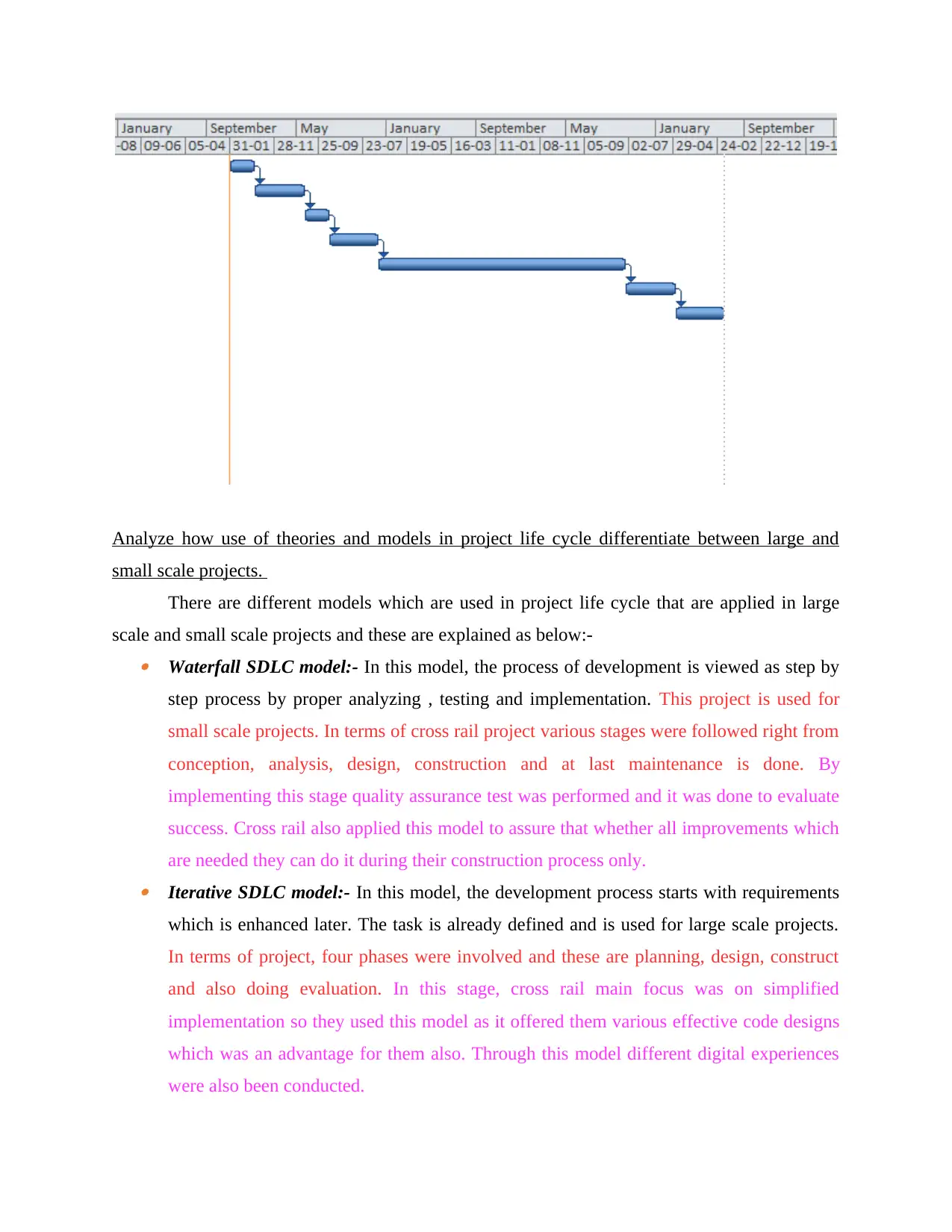
Analyze how use of theories and models in project life cycle differentiate between large and
small scale projects.
There are different models which are used in project life cycle that are applied in large
scale and small scale projects and these are explained as below:- Waterfall SDLC model:- In this model, the process of development is viewed as step by
step process by proper analyzing , testing and implementation. This project is used for
small scale projects. In terms of cross rail project various stages were followed right from
conception, analysis, design, construction and at last maintenance is done. By
implementing this stage quality assurance test was performed and it was done to evaluate
success. Cross rail also applied this model to assure that whether all improvements which
are needed they can do it during their construction process only. Iterative SDLC model:- In this model, the development process starts with requirements
which is enhanced later. The task is already defined and is used for large scale projects.
In terms of project, four phases were involved and these are planning, design, construct
and also doing evaluation. In this stage, cross rail main focus was on simplified
implementation so they used this model as it offered them various effective code designs
which was an advantage for them also. Through this model different digital experiences
were also been conducted.
small scale projects.
There are different models which are used in project life cycle that are applied in large
scale and small scale projects and these are explained as below:- Waterfall SDLC model:- In this model, the process of development is viewed as step by
step process by proper analyzing , testing and implementation. This project is used for
small scale projects. In terms of cross rail project various stages were followed right from
conception, analysis, design, construction and at last maintenance is done. By
implementing this stage quality assurance test was performed and it was done to evaluate
success. Cross rail also applied this model to assure that whether all improvements which
are needed they can do it during their construction process only. Iterative SDLC model:- In this model, the development process starts with requirements
which is enhanced later. The task is already defined and is used for large scale projects.
In terms of project, four phases were involved and these are planning, design, construct
and also doing evaluation. In this stage, cross rail main focus was on simplified
implementation so they used this model as it offered them various effective code designs
which was an advantage for them also. Through this model different digital experiences
were also been conducted.
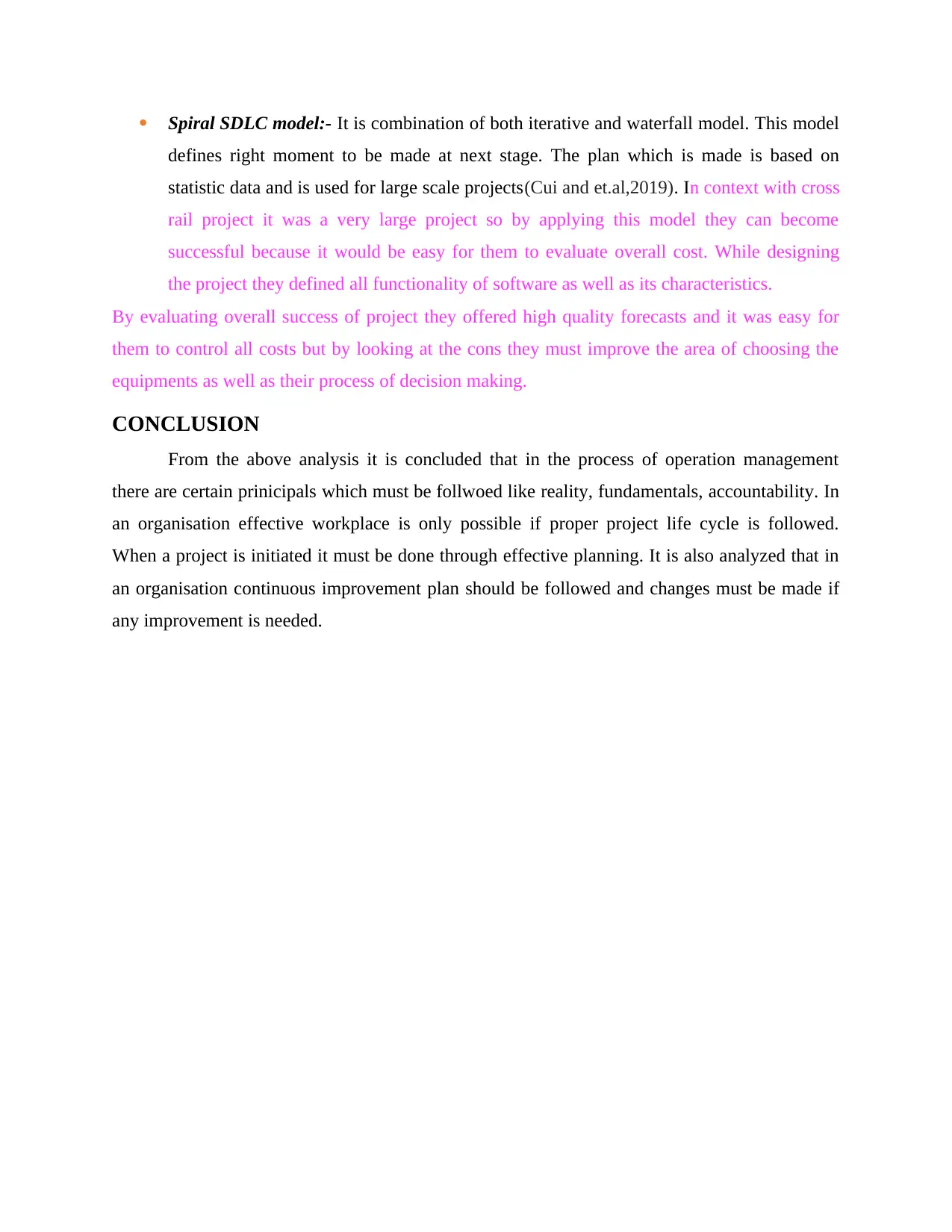
Spiral SDLC model:- It is combination of both iterative and waterfall model. This model
defines right moment to be made at next stage. The plan which is made is based on
statistic data and is used for large scale projects(Cui and et.al,2019). In context with cross
rail project it was a very large project so by applying this model they can become
successful because it would be easy for them to evaluate overall cost. While designing
the project they defined all functionality of software as well as its characteristics.
By evaluating overall success of project they offered high quality forecasts and it was easy for
them to control all costs but by looking at the cons they must improve the area of choosing the
equipments as well as their process of decision making.
CONCLUSION
From the above analysis it is concluded that in the process of operation management
there are certain prinicipals which must be follwoed like reality, fundamentals, accountability. In
an organisation effective workplace is only possible if proper project life cycle is followed.
When a project is initiated it must be done through effective planning. It is also analyzed that in
an organisation continuous improvement plan should be followed and changes must be made if
any improvement is needed.
defines right moment to be made at next stage. The plan which is made is based on
statistic data and is used for large scale projects(Cui and et.al,2019). In context with cross
rail project it was a very large project so by applying this model they can become
successful because it would be easy for them to evaluate overall cost. While designing
the project they defined all functionality of software as well as its characteristics.
By evaluating overall success of project they offered high quality forecasts and it was easy for
them to control all costs but by looking at the cons they must improve the area of choosing the
equipments as well as their process of decision making.
CONCLUSION
From the above analysis it is concluded that in the process of operation management
there are certain prinicipals which must be follwoed like reality, fundamentals, accountability. In
an organisation effective workplace is only possible if proper project life cycle is followed.
When a project is initiated it must be done through effective planning. It is also analyzed that in
an organisation continuous improvement plan should be followed and changes must be made if
any improvement is needed.
Secure Best Marks with AI Grader
Need help grading? Try our AI Grader for instant feedback on your assignments.
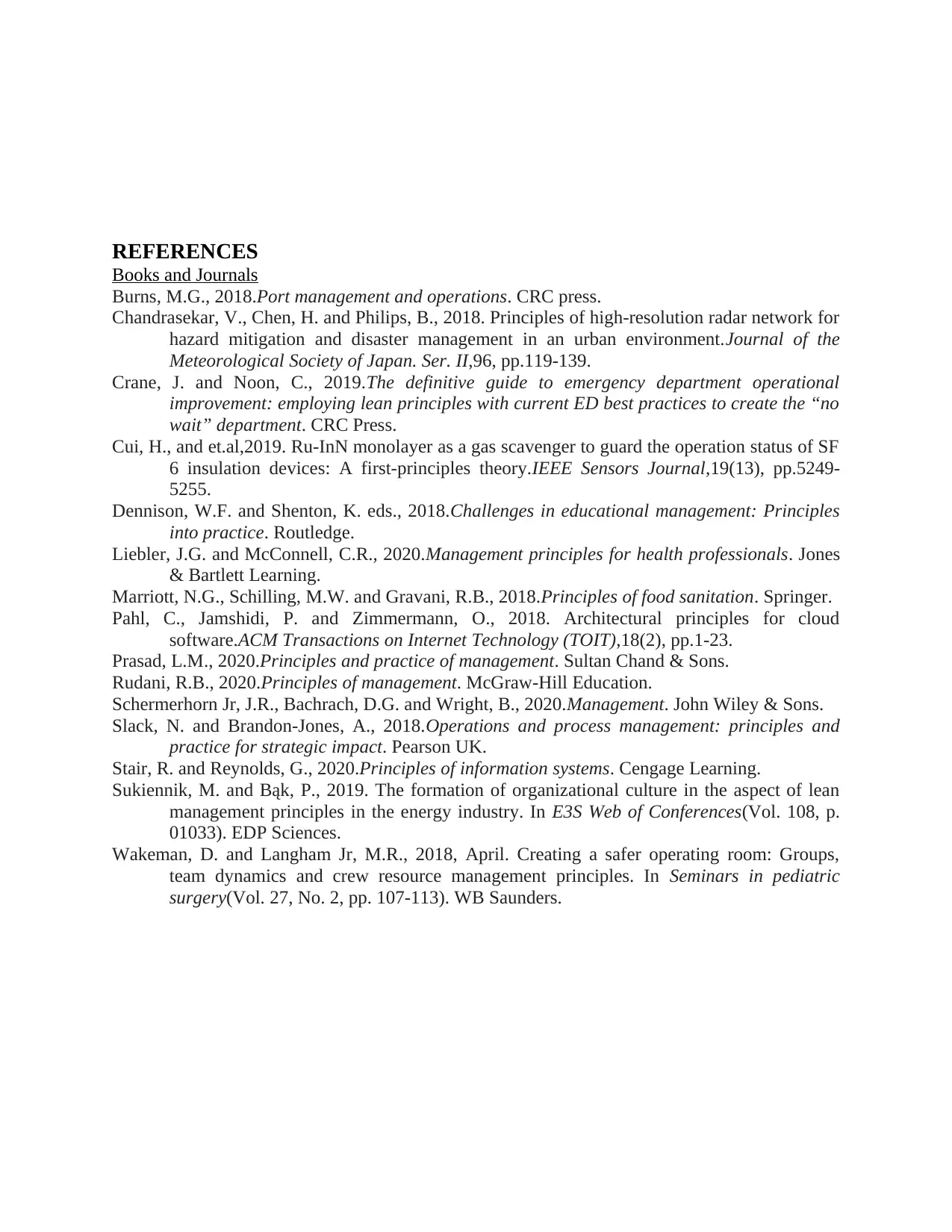
REFERENCES
Books and Journals
Burns, M.G., 2018.Port management and operations. CRC press.
Chandrasekar, V., Chen, H. and Philips, B., 2018. Principles of high-resolution radar network for
hazard mitigation and disaster management in an urban environment.Journal of the
Meteorological Society of Japan. Ser. II,96, pp.119-139.
Crane, J. and Noon, C., 2019.The definitive guide to emergency department operational
improvement: employing lean principles with current ED best practices to create the “no
wait” department. CRC Press.
Cui, H., and et.al,2019. Ru-InN monolayer as a gas scavenger to guard the operation status of SF
6 insulation devices: A first-principles theory.IEEE Sensors Journal,19(13), pp.5249-
5255.
Dennison, W.F. and Shenton, K. eds., 2018.Challenges in educational management: Principles
into practice. Routledge.
Liebler, J.G. and McConnell, C.R., 2020.Management principles for health professionals. Jones
& Bartlett Learning.
Marriott, N.G., Schilling, M.W. and Gravani, R.B., 2018.Principles of food sanitation. Springer.
Pahl, C., Jamshidi, P. and Zimmermann, O., 2018. Architectural principles for cloud
software.ACM Transactions on Internet Technology (TOIT),18(2), pp.1-23.
Prasad, L.M., 2020.Principles and practice of management. Sultan Chand & Sons.
Rudani, R.B., 2020.Principles of management. McGraw-Hill Education.
Schermerhorn Jr, J.R., Bachrach, D.G. and Wright, B., 2020.Management. John Wiley & Sons.
Slack, N. and Brandon-Jones, A., 2018.Operations and process management: principles and
practice for strategic impact. Pearson UK.
Stair, R. and Reynolds, G., 2020.Principles of information systems. Cengage Learning.
Sukiennik, M. and Bąk, P., 2019. The formation of organizational culture in the aspect of lean
management principles in the energy industry. In E3S Web of Conferences(Vol. 108, p.
01033). EDP Sciences.
Wakeman, D. and Langham Jr, M.R., 2018, April. Creating a safer operating room: Groups,
team dynamics and crew resource management principles. In Seminars in pediatric
surgery(Vol. 27, No. 2, pp. 107-113). WB Saunders.
Books and Journals
Burns, M.G., 2018.Port management and operations. CRC press.
Chandrasekar, V., Chen, H. and Philips, B., 2018. Principles of high-resolution radar network for
hazard mitigation and disaster management in an urban environment.Journal of the
Meteorological Society of Japan. Ser. II,96, pp.119-139.
Crane, J. and Noon, C., 2019.The definitive guide to emergency department operational
improvement: employing lean principles with current ED best practices to create the “no
wait” department. CRC Press.
Cui, H., and et.al,2019. Ru-InN monolayer as a gas scavenger to guard the operation status of SF
6 insulation devices: A first-principles theory.IEEE Sensors Journal,19(13), pp.5249-
5255.
Dennison, W.F. and Shenton, K. eds., 2018.Challenges in educational management: Principles
into practice. Routledge.
Liebler, J.G. and McConnell, C.R., 2020.Management principles for health professionals. Jones
& Bartlett Learning.
Marriott, N.G., Schilling, M.W. and Gravani, R.B., 2018.Principles of food sanitation. Springer.
Pahl, C., Jamshidi, P. and Zimmermann, O., 2018. Architectural principles for cloud
software.ACM Transactions on Internet Technology (TOIT),18(2), pp.1-23.
Prasad, L.M., 2020.Principles and practice of management. Sultan Chand & Sons.
Rudani, R.B., 2020.Principles of management. McGraw-Hill Education.
Schermerhorn Jr, J.R., Bachrach, D.G. and Wright, B., 2020.Management. John Wiley & Sons.
Slack, N. and Brandon-Jones, A., 2018.Operations and process management: principles and
practice for strategic impact. Pearson UK.
Stair, R. and Reynolds, G., 2020.Principles of information systems. Cengage Learning.
Sukiennik, M. and Bąk, P., 2019. The formation of organizational culture in the aspect of lean
management principles in the energy industry. In E3S Web of Conferences(Vol. 108, p.
01033). EDP Sciences.
Wakeman, D. and Langham Jr, M.R., 2018, April. Creating a safer operating room: Groups,
team dynamics and crew resource management principles. In Seminars in pediatric
surgery(Vol. 27, No. 2, pp. 107-113). WB Saunders.

1 out of 18
Related Documents
Your All-in-One AI-Powered Toolkit for Academic Success.
+13062052269
info@desklib.com
Available 24*7 on WhatsApp / Email
![[object Object]](/_next/static/media/star-bottom.7253800d.svg)
Unlock your academic potential
© 2024 | Zucol Services PVT LTD | All rights reserved.





